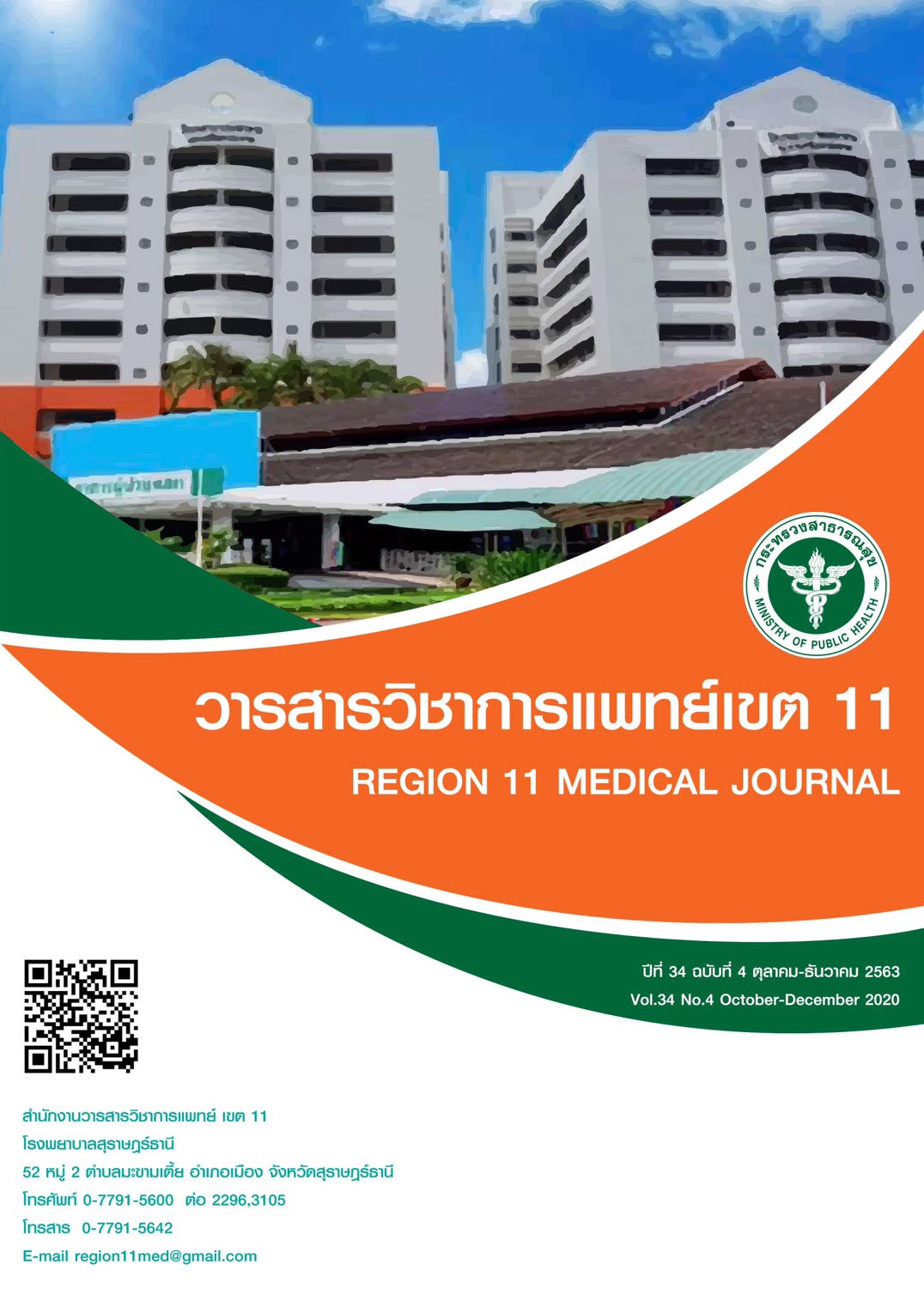Comparison of vision-specific quality of life in patients with monovision and binocular vision after cataract surgery
Keywords:
monovision, binocular vision, spectacle independence, vision-specific quality of life, near stereoacuity, monofocalAbstract
Background: After routine cataract surgery, the patients could have good distance vision, otherwise some patients need a wide range of vision and some need spectacle- free for near too. The monovision technique may be the option to meet their expectation.
Objective: To compare vision-specific quality of life in patients with monovision and binocular vision after cataract surgery.
Method: A prospective study of 80 patients (160 eyes) who underwent bilateral phacoemulsification with a monofocal IOL implantation; 40 with monovision, 40 with binocular vision. The monovision group was corrected a dominant eye as a distance eye with emmetropic target (±0.00 to -0.50 diopter (D)) and a non-dominant eye with myopic target (-1.00±0.50 D) whereas the binocular vision group was corrected both eyes as a distance vision. The outcome were a vision-specific quality of life assessed by a Catquest-9SF 2011 questionnaire preoperative and 6 weeks postoperative of the second eye , uncorrected near and distant binocular visual acuity, near stereoacuity, spectacle independence and postoperative refraction.
Results: The postoperative uniocular distance refraction in the monovision (M) group showed the mean spherical equivalent of -0.131D and -0.916 D. In the binocular vision (B) group the mean spherical equivalents were +0.088 D and +0.103 D. The near visual acuity (≤ J5) (M 90.0% vs B 30.0%) and spectacle independence (M 77.5% vs B 7.5%). The distance visual acuity (V.A.≥20/30) (B 100.0% vs M 95.0%) and the near stereoacuity (≤ 100 arc sec) (B 90.0% vs M 87.5%). The quality of life score of the monovision group was better than in the binocular vision group (35.78±0.73 vs 32.97±2.44) (p-value<0.001).
Conclusion: Patients in the monovision group provided a higher level of satisfaction than the binocular vision group by means of better vision-specific quality of life. Therefore the monovision technique seems to be a good choice for patients who need a wide range of vision and spectacle independence after cataract surgery.
References
Greenbaum S. Monovision pseudophakia. Journal of Cataract & Refractive Surgery. 2002;28(8):1439-43.
Zheleznyak L, Alarcon A, Dieter KC, Tadin D, Yoon G. The role of sensory ocular dominance on through-focus visual performance in monovision presbyopia corrections. Journal of vision. 2015;15(6):17.
Wilkins MR, Allan BD, Rubin GS, Findl O, Hollick EJ, Bunce C, et al. Randomized trial of multifocal intraocular lenses versus monovision after bilateral cataract surgery. Ophthalmology. 2013;120(12):2449-55. e1.
Zeri F, Berchicci M, Naroo SA, Pitzalis S, Di Russo F. Immediate cortical adaptation in visual and non‐visual areas functions induced by monovision. The Journal of physiology. 2018;596(2):253-66.
Lundstrom M, Behndig A, Kugelberg M, Montan P, Stenevi U, Pesudovs K. The outcome of cataract surgery measured with the Catquest‐9SF. Acta ophthalmologica. 2011;89(8):718-23.
Holden BA, Fricke TR, Ho SM, Wong R, Schlenther G, Cronjé S, et al. Global vision impairment due to uncorrected presbyopia. Archives of ophthalmology. 2008;126(12):1731-9.
Zettl S, Reiß S, Terwee T, Guthoff R, Beck R, Stachs O. Effect of pseudophacic mini-monovision as an option for independence of spectacles in everyday life. Klinische Monatsblatter fur Augenheilkunde. 2014;231(12):1196-202.
Goldberg DG, Goldberg MH, Shah R, Meagher JN, Ailani H. Pseudophakic mini-monovision: high patient satisfaction, reduced spectacle dependence, and low cost. BMC ophthalmology. 2018;18(1):293.
Labiris G, Toli A, Perente A, Ntonti P, Kozobolis VP. A systematic review of pseudophakic monovision for presbyopia correction. International Journal of Ophthalmology. 2017;10(6):992-1000.
Stock RA, Thumé T, Paese LG, Bonamigo EL. Subjective evaluation of uncorrected vision in patients undergoing cataract surgery with (diffractive) multifocal lenses and monovision. Clinical Ophthalmology (Auckland, NZ). 2017;11:1285-90.
Næser K, Hjortdal JØ, Harris WF. Pseudophakic monovision: optimal distribution of refractions. Acta ophthalmologica. 2014;92(3):270-5.
Hayashi K, Ogawa S, Manabe S-I, Yoshimura K. Binocular visual function of modified pseudophakic monovision. American journal of ophthalmology. 2015;159(2):232-40.
Zheleznyak L, Sabesan R, Oh J-S, MacRae S, Yoon G. Modified monovision with spherical aberration to improve presbyopic through-focus visual performance. Investigative ophthalmology & visual science. 2013;54(5):3157-65.
Shimizu K. Monovision strategies. CRST Europe. 2011;3:50-1.
Greenstein S, Pineda R, editors. The quest for spectacle independence: a comparison of multifocal intraocular lens implants and pseudophakic monovision for patients with presbyopia. Seminars in ophthalmology; 2017: Taylor & Francis.
Zhang F, Sugar A, Jacobsen G, Collins M. Visual function and patient satisfaction: comparison between bilateral diffractive multifocal intraocular lenses and monovision pseudophakia. Journal of Cataract & Refractive Surgery. 2011;37(3):446-53.






